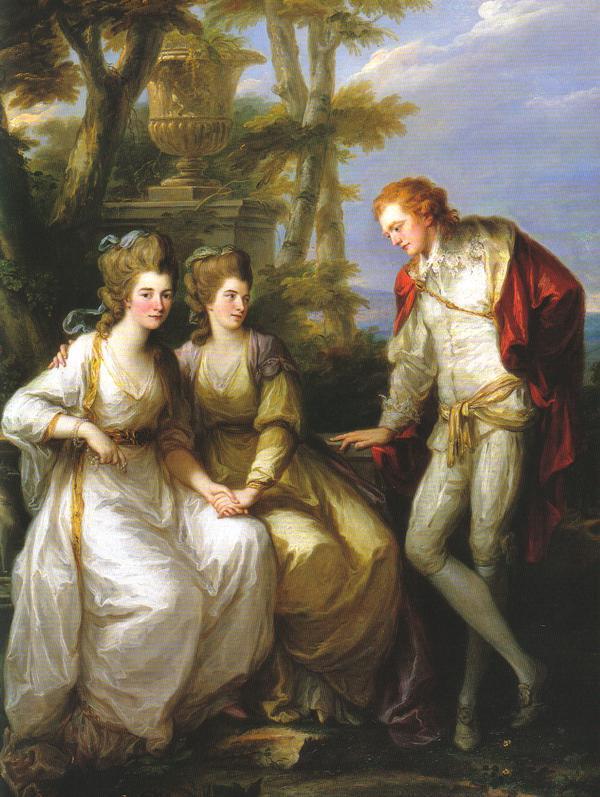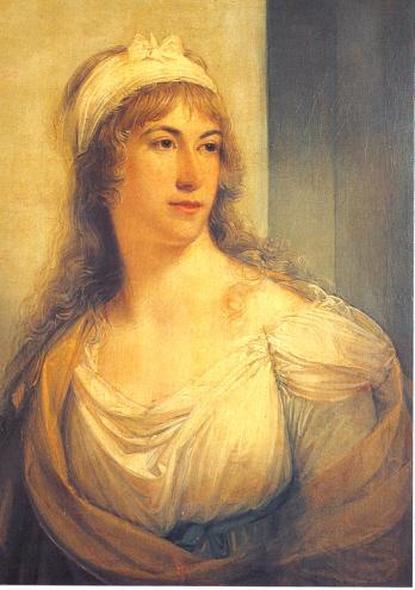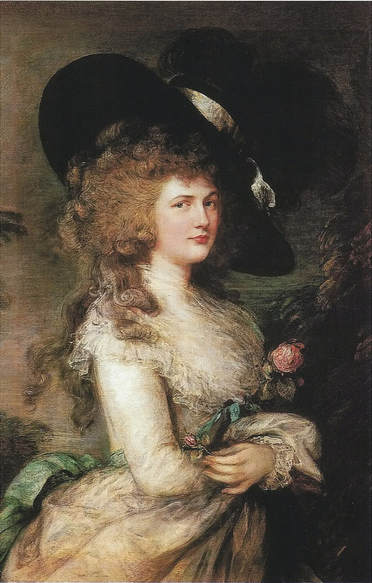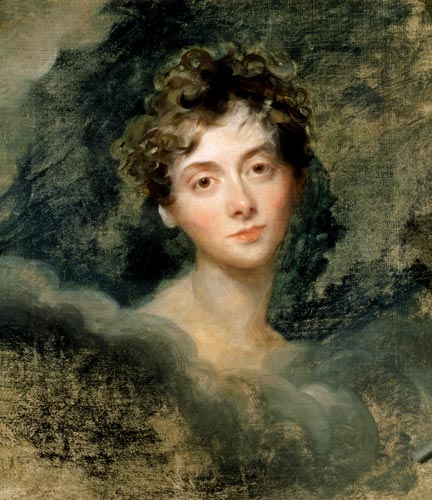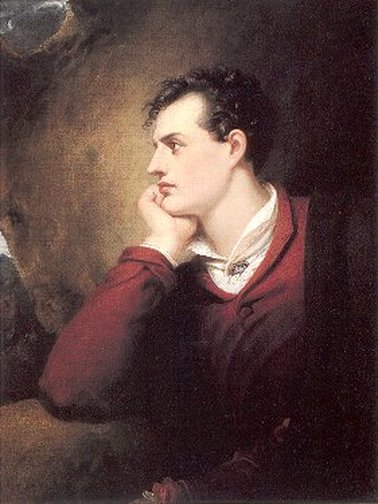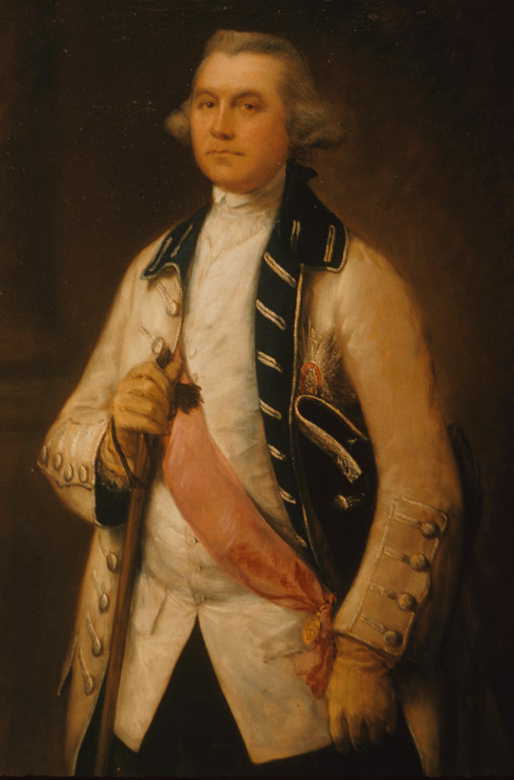|
The Scandalous Family of Mrs Anne Collins, Widow of Ashley Grove Andrew Gore Douglas June 2017 Andrew Douglas wrote to us asking for any information about Mrs Anne Collins, widow of Ashley Grove, Box, Wiltshire. He had discovered her name as a major beneficiary and the executrix in the will of Anna Susanna Ethelreda Gore, his ancestor. We couldn't help much but Andrew's research developed into an amazing article about two of the most notorious society ladies of the Georgian era and their connection with our village. Tasty stuff! Andrew's research is too extensive to reproduce all of it but he has kindly allowed us to make it into extracts. Left: Friends of Mrs Ann Collins in a portrait of Lady Georgiana and Lady Henrietta Frances Bessborough and George John Spencer, Viscount Althorp, in 1774 by Angelica Kauffmann (courtesy Wikipedia). |
Will of Anna Susanna Ethelreda Gore, 13 May 1793
The story starts with the benefactress, Anna Susanna Gore. She was born in 1773, the daughter of Lieutenant General Sir William Draper who had a distinguished military career in the British Army rising to high rank. She had married John Gore of Barrow and Christon on 17 May 1790 at St Marylebone, London. The marriage was short-lived and he died in 1792 aged 24.
Anna was extremely ill when she made her will aged just 21 and she died at Hotwells, Bristol, on 26 July 1793.[1] Hotwells was a place where many wealthy men and women came to drink the waters to improve various ailments. Knowing that her young husband had died intestate shortly beforehand, it was vitally important for her to arrange the family's financial affairs.
In her will she mentioned some tremendous sums, amounts of £6,000 and £8,000, in today's money three-quarters of a million pounds and over a million pounds respectively. Presumably her wealth came from her mother’s family the De Lanceys. Her mother was Susanna De Lancey of New York, North America. Her father met and married Susanna in North America in 1770 before the outset of the American War of Independence. The De Lancey family were one of the richest families in New York and, because they supported the British side in the conflict, certain of them ended their days living in England.
She requested to be buried next to her husband in the parish church at Christon and referred to her relatives, several of whom were extremely wealthy. They included her brother-in-law Rev Charles Gore, vicar of Henbury, her father the late Sir William Draper, Knight of the Bath, Daniel Draper of Westminster, Benjamin Ashe of Bath, the Hon Mrs Catharine Gordon of Putney, her two daughters Caroline and Katharine Gordon, and her mother-in-law Dame Barbara Mostyn. The will also mentioned the Box connection, Mrs Anne Collins of Ashley Grove, Box, Wiltshire, who was the executor and main beneficiary receiving eight thousand pounds plus shares in the newly-formed business, the Hull Dock Company.
The story starts with the benefactress, Anna Susanna Gore. She was born in 1773, the daughter of Lieutenant General Sir William Draper who had a distinguished military career in the British Army rising to high rank. She had married John Gore of Barrow and Christon on 17 May 1790 at St Marylebone, London. The marriage was short-lived and he died in 1792 aged 24.
Anna was extremely ill when she made her will aged just 21 and she died at Hotwells, Bristol, on 26 July 1793.[1] Hotwells was a place where many wealthy men and women came to drink the waters to improve various ailments. Knowing that her young husband had died intestate shortly beforehand, it was vitally important for her to arrange the family's financial affairs.
In her will she mentioned some tremendous sums, amounts of £6,000 and £8,000, in today's money three-quarters of a million pounds and over a million pounds respectively. Presumably her wealth came from her mother’s family the De Lanceys. Her mother was Susanna De Lancey of New York, North America. Her father met and married Susanna in North America in 1770 before the outset of the American War of Independence. The De Lancey family were one of the richest families in New York and, because they supported the British side in the conflict, certain of them ended their days living in England.
She requested to be buried next to her husband in the parish church at Christon and referred to her relatives, several of whom were extremely wealthy. They included her brother-in-law Rev Charles Gore, vicar of Henbury, her father the late Sir William Draper, Knight of the Bath, Daniel Draper of Westminster, Benjamin Ashe of Bath, the Hon Mrs Catharine Gordon of Putney, her two daughters Caroline and Katharine Gordon, and her mother-in-law Dame Barbara Mostyn. The will also mentioned the Box connection, Mrs Anne Collins of Ashley Grove, Box, Wiltshire, who was the executor and main beneficiary receiving eight thousand pounds plus shares in the newly-formed business, the Hull Dock Company.
Other Connections in the 1793 Will
Two intriguing bequests were made in a codicil to Anna's will. One is for a mahogany tea chest with silver canisters to be given to the Countess of Bessborough and the other is for the Countess’s daughter, Lady Caroline Ponsonsy better known as Lady Caroline Lamb, to receive a picture and a pair of gloves that were at the Earl of Bessborough’s in Cavendish Square. These requests suggest that a close friendship existed between Anna Susanna Gore and the Countess.
Two intriguing bequests were made in a codicil to Anna's will. One is for a mahogany tea chest with silver canisters to be given to the Countess of Bessborough and the other is for the Countess’s daughter, Lady Caroline Ponsonsy better known as Lady Caroline Lamb, to receive a picture and a pair of gloves that were at the Earl of Bessborough’s in Cavendish Square. These requests suggest that a close friendship existed between Anna Susanna Gore and the Countess.
Both the Countess and her daughter led notorious lives, having numerous marital affairs and several illegitimate children. How did Anna Susanna Gore become friends of the Countess? They were just about the same age and they may have all mixed in the same social circle, especially at Bath. Anna especially requests Mrs Anne Collins to collect all her papers, letters, pocket books etc and burn them all herself. Why? Would they, perhaps, have provided a source of scandal! Had Anna been involved in a relationship after her husband’s death and wanted Anne Collins to remove all evidence? It is possible.
You can read the full will in the document below.
You can read the full will in the document below.
| will_of_anna_susanna_ethelreda_gore_1793.pdf | |
| File Size: | 61 kb |
| File Type: | |
Countess of Bessborough and Lady Caroline Lamb
Before considering the Box connection of Anne Collins, we can review the lives of her associates, Henrietta Ponsonby (the Countess of Bessborough) and her daughter, Lady Caroline Lamb. They were leading society figures, related to some of the most important families of the age. Henrietta was born Lady Henrietta Frances Spencer, daughter of John Spencer, a great-grandson of John Churchill, Duke of Marlborough, and sister of the notorious Georgiana Cavendish, the Duchess of Devonshire. As an adult Henrietta was a woman of exceptional beauty and intelligence, witty, well-read and self-assured but addicted to gambling.
She was frequently in considerable debt and publically humiliated by her husband for her excessive living. She took numerous lovers, saying I can never love a little. She had several affairs with Charles Wyndham, one of the Devonshire House set, with the playwright Richard Brinsley Sheridan, and with the Earl of Granville, with whom she had two children. In addition she had four children with her husband.
Before considering the Box connection of Anne Collins, we can review the lives of her associates, Henrietta Ponsonby (the Countess of Bessborough) and her daughter, Lady Caroline Lamb. They were leading society figures, related to some of the most important families of the age. Henrietta was born Lady Henrietta Frances Spencer, daughter of John Spencer, a great-grandson of John Churchill, Duke of Marlborough, and sister of the notorious Georgiana Cavendish, the Duchess of Devonshire. As an adult Henrietta was a woman of exceptional beauty and intelligence, witty, well-read and self-assured but addicted to gambling.
She was frequently in considerable debt and publically humiliated by her husband for her excessive living. She took numerous lovers, saying I can never love a little. She had several affairs with Charles Wyndham, one of the Devonshire House set, with the playwright Richard Brinsley Sheridan, and with the Earl of Granville, with whom she had two children. In addition she had four children with her husband.
In 1791, Henrietta and her sister, Georgiana, were involved in a financial scandal, losing a fortune on a risky investment which failed. Her health collapsed and she moved to Bath to take the waters, later going abroad with her disgraced sister.
Henrietta's only legitimate daughter was Caroline, who was seven years-old at the date of Anna Gore's will. Like her mother she appears to have been highly intelligent, fluent in French and Italian, she studied Greek and Latin, enjoyed music and drama, wrote prose and poetry, and was a skilled sketch painter. But Caroline was capricious like her mother. In 1805 she married William Lamb, Lord Melbourne, who became Prime Minister of Britain in 1835. But it was her relationship with the poet Lord Byron in 1812 which scandalised society. At first she described Byron as mad, bad, and dangerous to know, but they started a brief, passionate love affair until she was spurned by him. Caroline openly threw herself at Byron in an attempt to continue their relationship and, when refused, slashed her wrists using a smashed wine glass at a society ball to show her despair. Her behaviour was the talk of the age, as famous as the defeat of Napoleon at the Battle of Waterloo in 1815, because it involved the author of Childe Harold's Pilgrimage and the leading politicians of the early Victorian era.
Henrietta's only legitimate daughter was Caroline, who was seven years-old at the date of Anna Gore's will. Like her mother she appears to have been highly intelligent, fluent in French and Italian, she studied Greek and Latin, enjoyed music and drama, wrote prose and poetry, and was a skilled sketch painter. But Caroline was capricious like her mother. In 1805 she married William Lamb, Lord Melbourne, who became Prime Minister of Britain in 1835. But it was her relationship with the poet Lord Byron in 1812 which scandalised society. At first she described Byron as mad, bad, and dangerous to know, but they started a brief, passionate love affair until she was spurned by him. Caroline openly threw herself at Byron in an attempt to continue their relationship and, when refused, slashed her wrists using a smashed wine glass at a society ball to show her despair. Her behaviour was the talk of the age, as famous as the defeat of Napoleon at the Battle of Waterloo in 1815, because it involved the author of Childe Harold's Pilgrimage and the leading politicians of the early Victorian era.
Mrs Anne Collins (died 1830)
Having described the people she mixed with, we return to the central question, who was Mrs Anne Collins of Ashley Grove? Part of the answer was revealed in an unattributed publication entitled Pitt’s Gallant Conquerors – The Turbulent Life of Lieutenant General William Draper. In recording the life of William Draper, the father of Anna Suzanna Gore, the publication confirms that William and Anne Collins were cousins: His two daughters, now motherless, were kept in the care of his cousin, Ann Collins, wife of the naval captain Richard Collins. She who had been a member of Sir William’s household for some years, would have been a family guardian to the two young girls, probably in Bath. The daughters were Anna Susanna and Phila born in 1773 and 1774 respectively. We might imagine that Anne Collins was the dependable relative, who the family turned to for stability in their chaotic lives.
In a book about naval matters I discovered a reference to Captain Richard Collins: The Terrible of 74 guns, Captain Richard Collins, which was attached to the Squadron under Admiral Saunders at the taking of Quebec would probably have been lost in the River St Lawrence but for the following expedient of a Warrant Officer then on board. When the ship drove from her anchors,
he secured one end of the Ship’s guns to two small anchors as had formerly been done by Anson in the Centurion, and this kept her post. The French ship Le Terrible was captured by the British in 1747 and took part in the siege of Quebec in 1759 under the control of Captain Collins during the Seven Years War with France. Captain Richard Collins left a will proved on his death on 7 October 1780 so in 1793 Anne Collins would have been a widow for more than 13 years.
Having described the people she mixed with, we return to the central question, who was Mrs Anne Collins of Ashley Grove? Part of the answer was revealed in an unattributed publication entitled Pitt’s Gallant Conquerors – The Turbulent Life of Lieutenant General William Draper. In recording the life of William Draper, the father of Anna Suzanna Gore, the publication confirms that William and Anne Collins were cousins: His two daughters, now motherless, were kept in the care of his cousin, Ann Collins, wife of the naval captain Richard Collins. She who had been a member of Sir William’s household for some years, would have been a family guardian to the two young girls, probably in Bath. The daughters were Anna Susanna and Phila born in 1773 and 1774 respectively. We might imagine that Anne Collins was the dependable relative, who the family turned to for stability in their chaotic lives.
In a book about naval matters I discovered a reference to Captain Richard Collins: The Terrible of 74 guns, Captain Richard Collins, which was attached to the Squadron under Admiral Saunders at the taking of Quebec would probably have been lost in the River St Lawrence but for the following expedient of a Warrant Officer then on board. When the ship drove from her anchors,
he secured one end of the Ship’s guns to two small anchors as had formerly been done by Anson in the Centurion, and this kept her post. The French ship Le Terrible was captured by the British in 1747 and took part in the siege of Quebec in 1759 under the control of Captain Collins during the Seven Years War with France. Captain Richard Collins left a will proved on his death on 7 October 1780 so in 1793 Anne Collins would have been a widow for more than 13 years.
|
Also, in the above mentioned publication, there were details of the Draper family. William Draper (born 1721) later to become Sir William Draper, had two daughters, one of whom was Anna Draper (born in 1716) who was sent to India as a child, marrying a surgeon there, Thomas Moore, before they both returned to England settling in Bristol where Thomas became a prosperous apothecary.
By good fortune a search revealed that both Thomas Moore and his wife Anna Moore (nee Draper) left wills. These revealed that their two daughters survived into adulthood being a Mary Ashe and an Anne (called in the will Anna) Collins, widow. This proved that the Mrs Anne Collins who brought up the two daughters of Major General Sir William Draper was in fact a niece (not cousin) of Sir William and a cousin to his children. Also both Thomas and Anna Moore were residents of Bladud Buildings. In her will, Anna Moore left that property to her daughter Anne Collins. By chance I came upon a will at the Public Record Office of an Anna Collins, widow, which was dated 1823 but not proved until 1830. I had missed it before because I looked for Anne or Ann Collins only. What was interesting in the will was a reference to my shares in the Hull Docks. Anna Susanna Gore had bequeathed her shares in that company to Mrs Anna Collins. This seemed to be more than just a coincidence. Another factor was a reference to her place of residence as being Bladud Buildings, Bath. I believe that Ann, Anne and Anna Collins are all the same person. |
| will_of_anna_collins_1830.pdf | |
| File Size: | 66 kb |
| File Type: | |
Ashley Grove
In the Georgian period Ashley Grove was both a grand house and an area of land. A description of the residence was later given as freehold detached residence with coach house, stables, greenhouse, vinery, field and cottages; and also of a long leasehold field, garden and cottages adjoining.[2] The house comprised an entrance-floor, vestibule and ante-room, dining room, double drawing-room, breakfast room, kitchen, side kitchen, scullery and offices; on the first and second floors six bedrooms and large store-room; on basement cellarage and dairy. At the end of the Flower Garden were three glasshouses: a fernery and two vineries and three-quarters of an acre of orchard. It also had Four Cottages with garden ground appropriate to each and a Close of good pasture land with frontage to the main road, comprising nearly two acres.
We don't know if Anna Collins owned or rented the property. In 1786 an Anna Collins purchased 6 Rivers Street, Bath in 1786 and sold it in 1801 to Colonel Lambert, who was in the service of the East India Company.
In the Georgian period Ashley Grove was both a grand house and an area of land. A description of the residence was later given as freehold detached residence with coach house, stables, greenhouse, vinery, field and cottages; and also of a long leasehold field, garden and cottages adjoining.[2] The house comprised an entrance-floor, vestibule and ante-room, dining room, double drawing-room, breakfast room, kitchen, side kitchen, scullery and offices; on the first and second floors six bedrooms and large store-room; on basement cellarage and dairy. At the end of the Flower Garden were three glasshouses: a fernery and two vineries and three-quarters of an acre of orchard. It also had Four Cottages with garden ground appropriate to each and a Close of good pasture land with frontage to the main road, comprising nearly two acres.
We don't know if Anna Collins owned or rented the property. In 1786 an Anna Collins purchased 6 Rivers Street, Bath in 1786 and sold it in 1801 to Colonel Lambert, who was in the service of the East India Company.
Family Tree
Lieutenant General Sir William Draper, Knight of the Bath (born 1721 at Bristol and died 1787) and his second wife Susanna De Lancey, daughter of Oliver De Lancey of New York. Children:
Anna Susanna Ethelreda Draper (born 1773 and died at Hotwells, Bristol 26 July 1793) who married John Gore of Barrow and Christon; Phila Draper.
Anna Moore (nee Draper) and William Draper were siblings. Anna Moore's children:
Anna Collins (died 1830) was married to Captain Richard Collins (died 1780); Mary Ashe (died 1817) was married to Benjamin Ashe (1741-1805)
Lieutenant General Sir William Draper, Knight of the Bath (born 1721 at Bristol and died 1787) and his second wife Susanna De Lancey, daughter of Oliver De Lancey of New York. Children:
Anna Susanna Ethelreda Draper (born 1773 and died at Hotwells, Bristol 26 July 1793) who married John Gore of Barrow and Christon; Phila Draper.
Anna Moore (nee Draper) and William Draper were siblings. Anna Moore's children:
Anna Collins (died 1830) was married to Captain Richard Collins (died 1780); Mary Ashe (died 1817) was married to Benjamin Ashe (1741-1805)
Sources
Rachel Knowles, Henrietta Ponsonby, Countess of Bessborough (1761-1821), Regency History Blog, http://www.regencyhistory.net/2012/10/henrietta-ponsonby-countess-of.html
Weinreb, Almack’s Assembly Rooms :The Dukes of Buckingham and Chandos, Retrieved 21 February 2010, ttps://www.revolvy.com/main/index.php?s=Lady%20Caroline%20Lamb
Teresa Grant, Imperial Scandal, 2012, Malcom & Suzanne Rannoch Historical Mysteries
Paul Douglass, Lady Caroline Lamb: A Biography, 2004, Palgrave & Macmillan
Sir David Cecil, The Young Melbourne and the Story of his Marriage with Caroline Lamb, 1939, reprinted 1948 and 1954
Amanda Foreman, Georgiana, Duchess of Devonshire, 1998, Modern Library
Janet Gleeson, An Aristocratic Affair, Historical Novel Society
Wikipedia
Rachel Knowles, Henrietta Ponsonby, Countess of Bessborough (1761-1821), Regency History Blog, http://www.regencyhistory.net/2012/10/henrietta-ponsonby-countess-of.html
Weinreb, Almack’s Assembly Rooms :The Dukes of Buckingham and Chandos, Retrieved 21 February 2010, ttps://www.revolvy.com/main/index.php?s=Lady%20Caroline%20Lamb
Teresa Grant, Imperial Scandal, 2012, Malcom & Suzanne Rannoch Historical Mysteries
Paul Douglass, Lady Caroline Lamb: A Biography, 2004, Palgrave & Macmillan
Sir David Cecil, The Young Melbourne and the Story of his Marriage with Caroline Lamb, 1939, reprinted 1948 and 1954
Amanda Foreman, Georgiana, Duchess of Devonshire, 1998, Modern Library
Janet Gleeson, An Aristocratic Affair, Historical Novel Society
Wikipedia
References
[1] Wikipedia
[2] Bath Chronicle and Weekly Gazette, 20 May 1886
[1] Wikipedia
[2] Bath Chronicle and Weekly Gazette, 20 May 1886
